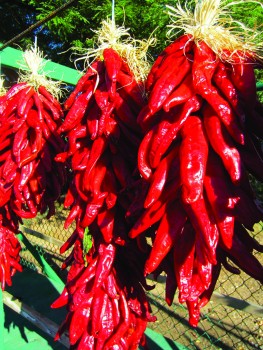A ristra is an arrangement of drying chile pepper pods. Historically, the pods were thrown up on the roofs of houses to dry but eventually it became more functional to hang them so they received better circulation.
Hatch, New Mexico is the world capital of chile growing, stringing and sales. As the harvest begins in August and September each year, the air becomes pungent with the wonderful aroma of chiles.
Green Sandia chiles are roasted, canned, pickled—served many different ways. If the chile stays on the vine until it turns red, the pods are then strung, topped with raffia and sold for functional or decorative purposes. The red chiles may be picked off the ristra and ground into chile powder or used in making chile sauce for many Mexican dishes.
Decoratively, ristras are often hung next to the front door of a house, signifying welcome to visitors, good luck and good fortune to all.
Originally, chile was found only in the Americas, having been domesticated for 7,000 years. Spanish explorers in the late 1500s reported that they found Pueblo Indians of New Mexico growing a mild variant form of chile. It is often considered an annual, however, in suitable climates, it becomes a small perennial shrub that can live for a decade or more. It was introduced to Europe by Columbus and has spread so widely, a quarter of the population of the world eats hot chile every day.
To discourage mammals from eating the chile because their digestive systems destroy the seeds, it evolved pungency. Birds don’t feel the heat and disseminate the seeds so the chile historically has spread. The pungency is affected by the genetic makeup of the variety, the weather, growing conditions and age of the fruit.
Chiles are an important source of vitamins and many essential nutrients. A green chile pod can contain six times as much vitamin C as a Florida orange. The content diminishes about 30% with cooking and is absent in dried Chile. As the pods dry, the vitamin A content increases until they contain twice as much as a carrot.
The pungency does not come from the chile seeds but from glands located along the fruit’s inner wall. Alkaloid compounds called capsaicinoids are the source. Pharmaceutical companies use capsaicin as a topical agent in creams and liniments for sore muscles or chronic pain. It is also the active ingredient in anti-mugger aerosols used by many police departments.
The closer to the time of their harvest, the fuller and heavier the chiles and the ristras are. By the time of year end, the drier chiles become available—a darker burgundy red in color and much lighter and more brittle.
Harry March, owner of Native Gardens of Green Valley, has been making the drive to Hatch several times each fall since 1990. Early in the season, he brings back ristras of both Sandia and the tiny Pequin chiles. As the holidays near, he has coronas (wreaths) made of the chiles as well as hearts and crosses.

